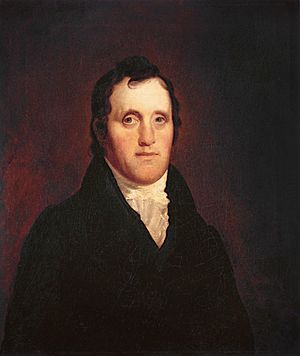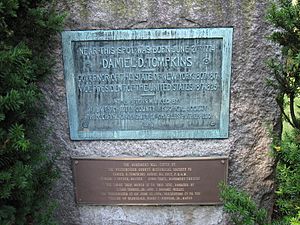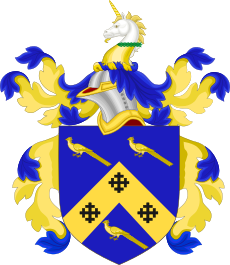Daniel D. Tompkins facts for kids
Quick facts for kids
Daniel D. Tompkins
|
|
|---|---|

Official Portait c. 1817
|
|
| 6th Vice President of the United States | |
| In office March 4, 1817 – March 4, 1825 |
|
| President | James Monroe |
| Preceded by | Elbridge Gerry |
| Succeeded by | John C. Calhoun |
| 4th Governor of New York | |
| In office July 1, 1807 – February 24, 1817 |
|
| Lieutenant | John Broome DeWitt Clinton John Tayler |
| Preceded by | Morgan Lewis |
| Succeeded by | John Tayler (acting) |
| Associate Justice of the New York Supreme Court of Judicature | |
| In office July 2, 1804 – July 1, 1807 |
|
| Succeeded by | William W. Van Ness |
| Member of the New York State Assembly from New York County | |
| In office July 1, 1802 – June 30, 1803 |
|
| Personal details | |
| Born | June 21, 1774 Scarsdale, Province of New York, British America (now New York, U.S.) |
| Died | June 11, 1825 (aged 50) Castleton, Staten Island, New York, U.S. |
| Resting place | St. Mark's Church in-the-Bowery |
| Political party | Democratic-Republican |
| Spouse | Hannah Minthorne |
| Children | 8, including Minthorne |
| Education | Columbia University (BA) |
| Signature | |
Daniel D. Tompkins (born June 21, 1774 – died June 11, 1825) was an important American politician. He served as the fifth governor of New York from 1807 to 1817. After that, he became the sixth vice president of the United States from 1817 to 1825.
Tompkins was born in Scarsdale, New York. He studied law at Columbia College and became a lawyer in New York City. He was part of the New York State Constitutional Convention in 1801. He also served as a judge on the New York Supreme Court from 1804 to 1807.
In 1807, Tompkins was elected Governor of New York. He stayed in this role for ten years, including during the War of 1812. During the war, he often used his own money to help pay and equip the state's soldiers.
Tompkins became the vice president in 1817, serving with President James Monroe. He was the only vice president in the 1800s to serve two full terms. He died in June 1825, shortly after leaving office.
Contents
What's in a Name?
Tompkins was originally named Daniel Tompkins when he was born. He added the middle initial "D." when he was a student at Columbia College. This was to tell himself apart from another student named Daniel Tompkins. People have wondered what the "D." stood for. Most agree that it didn't stand for anything special. It was just a way to make his name unique.
Early Life and Family
Daniel D. Tompkins was born on June 21, 1774, in Scarsdale, New York. His family lived on an estate called Fox Meadow. His older brother, Caleb Tompkins, also became a politician. Daniel graduated from Columbia College in 1795. He then studied law and became a lawyer in 1797.
Even though his law teachers were from the Federalist Party, Tompkins chose to join the Democratic-Republican Party. He helped write the New York State Constitutional Convention in 1801. In 1804, he became a member of the New York State Assembly. At just 30 years old, he was appointed a judge on the New York Supreme Court. He served as a judge until 1807.
In 1798, Daniel Tompkins married Hannah Minthorne. She was 16 years old. They had eight children together. One of their children, Minthorne Tompkins, later became a politician too. The Tompkins family also took care of a young boy named Henry Brewerton. He later became an engineer officer in the army.
The area called Tompkinsville on Staten Island is named after Daniel D. Tompkins. In 1815, he started a settlement there. He bought land and built his main home on Fort Hill. Streets in Tompkinsville are named after his children, Hannah and Minthorne.
Serving as Governor
On April 30, 1807, Daniel D. Tompkins won the election for Governor of New York. He defeated the current governor, Morgan Lewis. Tompkins stayed in office as governor until 1817. He was reelected three times.
During the War of 1812, Tompkins was a very strong leader for New York. He helped organize the state's soldiers, known as the state militia. He also encouraged the creation of a state military force. President James Madison offered him a job as United States Secretary of State in 1814. But Tompkins chose to stay as governor to help with the war effort. He became the commander of the federal military district that included New York City.
In 1815, Governor Tompkins started a settlement on Staten Island called Tompkinsville. He built a dock there in 1817. This dock offered daily steam ferry service between Staten Island and Manhattan.
In 1817, Governor Tompkins made an important suggestion. He proposed that July 4, 1827, be the day when all enslaved people in New York state would be freed. This included those who were not covered by an earlier law. This day became a special celebration for African Americans in New York.
Vice President of the United States
Many people in New York wanted Tompkins to become president in 1816. However, James Monroe received the nomination for president. Tompkins was chosen as Monroe's running mate for vice president. They won the election easily. Tompkins was re-elected in 1820. He served as vice president from March 4, 1817, to March 4, 1825.
While he was vice president, Tompkins ran for Governor of New York again in 1820. He lost that election to DeWitt Clinton. In 1821, he was a delegate to the New York State Constitutional Convention. He served as its president.
When Tompkins became vice president, he was not in good health. He had also spent a lot of his own money to help New York during the War of 1812. He didn't keep good records of these expenses. Because of this, both the New York government and the federal government did not fully pay him back. These money problems and his health issues meant he spent much of his time away from Washington, D.C.. In 1823, he finally received some money from the federal government.
Personal Life and Interests
Beyond his political work, Daniel D. Tompkins was also involved in Freemasonry. He was the first leader of a group called the Northern Masonic Jurisdiction Scottish Rite. He held this position from 1813 to 1825.
Death
Tompkins died in Tompkinsville on June 11, 1825. This was just 99 days after he left office. He was also 10 days shy of his 51st birthday. He was buried in the Minthorne family vault at St. Mark's Church in-the-Bowery in New York City. His wife was also buried there. He lived the shortest life of any U.S. vice president. He was also the youngest U.S. vice president until John C. Breckinridge took office in 1857.
Tompkins' Legacy
Many places are named after Daniel D. Tompkins. The Tompkinsville neighborhood on Staten Island is named for him. The streets there are named after his children. A Masonic lodge in the town is also named in his honor. Tompkins helped start the Brighton Heights Reformed Church on Staten Island in 1823.
During the War of 1812, four forts in New York State were named after Governor Tompkins. These were in Staten Island, Sackets Harbor, Buffalo, and Plattsburgh.
Other places named after him include:
- Tompkins Park in Bedford Stuyvesant, Brooklyn, New York (now Herbert Von King Park).
- Tompkins Avenue and Tompkins Public Houses in Brooklyn.
- Tompkins County in New York.
- Tompkins Square Park in Manhattan.
- Public School 69 Daniel D. Tompkins School in Staten Island.
- The Town of Tompkins.
- Tompkins Road in Scarsdale, New York.
- Tompkinsville, Kentucky, which is the county seat of Monroe County, Kentucky. Monroe County is named after President James Monroe.
Tompkins was also the Grand Master of the Grand Lodge of New York from 1820 to 1822. The Daniel D. Tompkins Memorial Chapel at the Masonic Home in Utica, New York, was built in his honor in 1911.
Daniel D. Tompkins was even mentioned in the 1947 movie Miracle on 34th Street. However, the movie incorrectly said he was vice president under John Quincy Adams. Tompkins was actually vice president under James Monroe.
See also
 In Spanish: Daniel D. Tompkins para niños
In Spanish: Daniel D. Tompkins para niños




